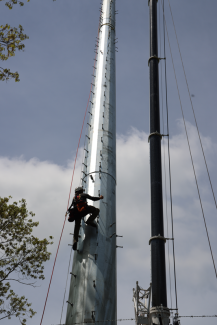Rhode Island Communications Statewide Communications Network (RISCON)

RISCON is a critical tool in enhancing emergency management, public safety, and interagency coordination across the state. Designed to ensure effective communication during emergencies, RISCON serves as the backbone of Rhode Island’s public safety communication infrastructure, supporting first responders, government agencies, and other vital public safety services.
RISCON’s establishment and usage are governed by Rhode Island state law, which mandates its role in emergency management efforts. Under R.I. Gen Laws § 30-15-2, which outlines the powers and duties of the Rhode Island Emergency Management Agency, the state is required to develop and maintain a robust communication system for emergency preparedness and response.
What is RISCON?
RISCON is a comprehensive, statewide communications system designed to provide real-time voice and data services for emergency responders, governmental organizations, and public safety agencies across the state. It facilitates interoperable communication for police, fire, emergency medical services, and other essential public services during normal operations and major events or disasters. By providing a reliable platform for communication, RISCON ensures that agencies can coordinate their response efforts efficiently, improving the state’s overall ability to manage crises and protect its citizens.
The Role of RISCON
RIEMA plays a pivotal role in managing disaster response and mitigation efforts throughout the state. RISCON is essential in this mission, offering the technological infrastructure necessary for effective communication during a crisis.
RIEMA relies on RISCON to:
- Coordinate multi-agency responses: Ensure that communication between various first responder agencies and public service organizations remains uninterrupted during emergencies.
- Support emergency operations centers (EOCs): RISCON serves as the communications foundation for Rhode Island's EOCs, helping to manage resource allocation, logistical support, and the flow of critical information during disasters.
- Enhance situational awareness: With RISCON, RIEMA can gather, assess, and disseminate information quickly, allowing for more informed decision-making during emergencies.
Why RISCON Matters
RISCON is more than just a communication tool—it’s an essential part of Rhode Island’s preparedness for any emergency. Whether it’s a natural disaster, severe weather event, or an unforeseen crisis, RISCON ensures that agencies are equipped to handle any situation and that Rhode Islanders are kept safe and informed.
How RISCON is Used
RISCON is a state-of-the-art, multi-agency communication system that integrates voice, data, and video communications into a single network. Here's how it is used:
- Voice Communication: First responders, public safety officials, and agencies can use RISCON’s secure and reliable radio system for voice communication during emergencies.
- Data Sharing: RISCON enables agencies to share vital data in real-time, including incident reports, situational updates, and resource allocation.
- Interagency Coordination: With RISCON, Rhode Island agencies can seamlessly share information and coordinate efforts with local, state, and federal partners.
- Public Alerts and Notifications: RISCON is integrated into public notification systems, such as the Emergency Alert System (EAS), to send critical messages to Rhode Island residents during emergencies. RIEMA staff works on VHF connections to Emergency Alert Systems (EAS)
- Mutual Aid Assistance: RISCON allows neighboring jurisdictions to assist one another by providing communication access in case of cross-jurisdictional incidents or large-scale events.
- Interoperability: The ability of different emergency response agencies and sometimes other government entity, to communicate with each other seamlessly, regardless of the specific communication systems they uses.
